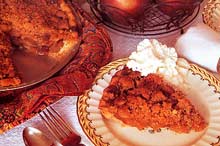Elements of a Perfect Apple Pie
The prize-winning apple pie marries an exemplary crust with tree-ripened apples that contribute acid, tannin, sugar, and flavor. A bad crust with the best apples makes a fair pie, and a good crust with fair apples makes a good pie, but a good crust with great apples makes an excellent and memorable pie. Remember that the flavor of the apples and the crust should dominate the pie, not spices, excessive sugar, or lemon juice.

In colonial America, 'Rhode Island Greening' in New England and 'Winesap' and 'Stayman' in the Mid-Atlantic states were the choices for pie making, equivalent to today's 'Granny Smith'. The classic pie maker of England was 'Bramley's Seedling', which contains an extraordinary 1 percent acid, one of the highest of all apple varieties. Except from specialty orchards, it is seldom available in North America or England but is worth seeking out.
If these classic pie apples are not available, one or two sweet varieties blended with one or two tart (acid-tannin) varieties from the chart below will make hundreds of taste combinations. Part of the success in making a memorable pie is variety selection and the quality of these varieties.
The Perfect Apple Pie
Here is a basic apple pie recipe from the Home Comfort cookbook that my grandparents received with the purchase of a super-fancy wood-burning cookstove in the early 1930s. Characteristic of many recipes of the time, it assumes a certain level of cooking and baking skill. I've added the baking temperature that works for most apple pies.
Making the Crust
- 1-1/2 cups flour
- 6 tablespoons shortening (vegetable or lard)
- 1 teaspoon baking powder
- 1/4 cup cold water
- 1/2 teaspoon salt
These ingredients will make one two-crust pie.
Sift flour, baking powder, and salt together. Cut in cold shortening with a dough blender until it resembles coarse meal. Add cold water slowly until the dough is moist enough to stick together but not so sticky it clings to hands or bowl. You may need one or two more tablespoons of cold water, depending on the kind of flour. Divide the dough in half and chill for about an hour; then put each half on a lightly floured board and roll out with light outward motions until it is 1/4-inch thick. Put one half in a pie pan, pat down, and trim off the surplus. Press down the edges with a fork or finger. Prick the bottom with a fork a few times. Bake in a hot oven (400°F) until slightly browned.
Assembling the Apple Pie
- 6 to 8 medium-sized apples
- 1/8 teaspoon salt
- 1/2 to 2/3 cup white or brown sugar
- 1 to 1-1/4 tablespoons cornstarch
- 1/2 teaspoon cinnamon
- 1-1/2 tablespoons butter
- 1/8 teaspoon nutmeg
Peel, core, and thinly slice the apples. Sift the sugar, cornstarch, spices, and salt over the apples and stir gently until they are well coated. Place the apples in layers in the half-baked pie shell, dotting each layer with bits of butter. If the apples are dry, add 2 tablespoons of water or cream. Cover with the pricked upper crust and bake in a hot oven (400°F) until done, about 30 or 40 minutes.
Apples for Pies
The apples in this chart have been divided into three groups based on the balance of acid, tannin, and sugar they contain. Acid-tannin varieties require blending with sugar or acid-tannin-sugar varieties. Acid-tannin-sugar varieties alone make a good pie. Sugar varieties need acid and tannin from apples in the other columns.
Acid-Tannin Varieties
- 'Arkansas Black'
- 'Baldwin'
- 'Cortland'
- 'Duchess of Oldenburg'
- 'Granny Smith'
- 'Gravenstein'
- 'Jonathan'
- 'Lodi'
- 'Lowland Raspberry'
- 'Mammoth Blacktwig'
- 'Red Astrachan'
- 'Rhode Island Greening'
- 'Stayman'
- 'Winesap'
- 'Yellow Transparent'
Acid-Tannin-Sugar Varieties
- 'Golden Russet'
- 'Goldrush'
- 'Idared'
- 'McIntosh'
- 'Newtown Pippin'
- 'Northern Spy'
- 'Ralls Genet'
- 'Razor Russet'
- 'Roxbury Russet'
- 'Smokehouse'
- 'Spartan'
- 'York'
Sugar Varieties
- 'Gala'
- 'Golden Delicious'
- 'Grimes Golden'
- 'Red Delicious'


